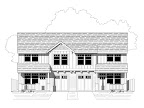Walls are so misunderstood. In a world of "More wood is better!" it's hard to know what to cut. Efficiency by Design can optimize your walls to help you know what's what and what to cut.
What's in a wall? There are three basic parts: First are the studs that stand straight up. These are held in place by plates at the top and bottom. Finally all of it is tied together with sheathing. How do they work?
The studs have two tasks. The first is to provide some strength against gravity loads. The code asks for studs to be installed at 24" on center in most cases and 16" o.c. in other cases. This spacing ensures that weight is distributed evenly throughout the wall. Yes, we often poke openings in walls and install headers but those can be calculated to be the most optimal.
The studs have another job; they hold up your sheathing. More on that in a moment.
The plates tie all the studs together. There are usually a bottom plate (or sill plate) and two top plates. Once the studs and plates are connected, you have the basic skeleton for a wall. Of course there are other members such as sills, headers, cripples, etc., but we'll look at those later.
Once the skeleton is built, it can be sheathed. In higher seismic zones, plywood or OSB is used on all of the outside. In lighter seismic zones, exterior wood may only be on the corners with an occasional middle panel. Or maybe there's no wood sheathing, just let-in bracing. Then the whole house is wrapped in rigid foam and sided over.
So what can we eliminate? As mentioned, exterior wood sheathing can be stripped in lighter seismic zones. What about zones D and E? Why not remove studs? No? What is their purpose anyway? Mostly to hold sheathing in place which is acting as the wind and seismic deterrent.
How do you remove studs? In a multitude of ways. Sometimes a specification or note on the plan can naturally remove studs. Other times a little design sense can help keep other studs out of the house. In all but the first of a three story house you can use 2x6 @ 24" o.c. studs (Table R602.3(5)). But here's the thing. If you promise me you will align all your joists to stack over each stud, I can design you a 3 story wall of 2x6 @ 32" o.c. Of course, there are other issues that come into play such as sheathing type, but I hope you get the point.
So studs can be spaced out with no ill effects to the strength of the house. Where else can studs be removed? How about at a window? Between king studs, jack studs, trimmers and cripples, windows are over built. Here are some simple ideas:
- Remove the header
- Instead of a trimmer and a jack stud, use a split trimmer instead
- If the vertical space above the window is 24" or less, don't install cripples
- Move or resize windows to make king studs out of the natural studs
There are several places where beams can be eliminated. In a two story home it is all but useless to add headers over 36" wide openings unless there is a large point load above. In most cases the rim joist above can handle the load just fine. Even a double top plate is an adequate header for smaller openings. Your designer can show this with calculations.
Of course windows and headers aren't the only place to reduce studs. Corner and T-wall intersections often use an extra stud or two each. The only use for these extra studs is as a backer for interior sheathing. If they're only backer, is there another product or method that can be used?
Certainly! But it depends on the experience of your drywaller. Many drywallers will fasten gypsum board to every piece of wood available. It's the fastening that's the problem. Fastening drywall to both sides of a corner and then each other heightens the susceptibility to cracking. Three different attachment points mean three different reactions and a higher risk of cracks.
But if only one sheet of drywall is attached to the wall and the other floats, what do you suppose will happen? The natural settling and movement of the wood will react against just one attachment and the cracks (and callbacks) will drop dramatically.
For this to work, there needs to be two things: A backer and a drywaller who knows where not to attach to. Simply using scraps of OSB for the backer is enough. Drilling or nailing into this backer is not advised as it can blow it out. This is where you need an established sub to do the job.
A final note about saving studs. Some simple design changes can reduce the amount of needed studs. If your designer is willing to make changes, modify jogs to be a factor of your framing spacing. Ideally that will be 24" but if you must, 16" is acceptable. At a minimum, thinking in 8" increments will be the most viable optimization of materials.
These techniques are not difficult. We have spent years testing and honing them to find out what works and doesn't. Simply begin the conversation with an email or phone call. We'll handle the rest.







No comments:
Post a Comment